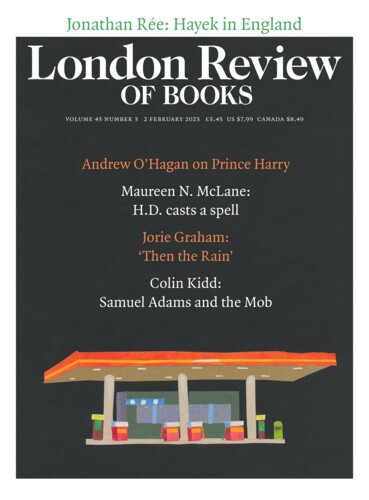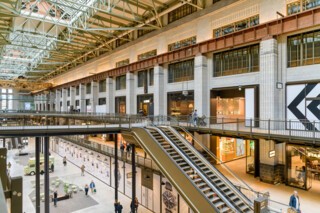My father lived in West London in the late 1950s and early 1960s, a time when, on high ground, Battersea power station dominated the skyline. These days he travels regularly along the Southampton-Waterloo line, originally the South Western Railway. Where the line’s depot once stood at Nine Elms, there is a chaos of luxury investment vehicles, towers sprouting in every available space and wrapping around the power station itself. ‘If I could, I would bomb it,’ he tells me, every time I see him. ‘All of it. All of those towers – plant a load of bombs and blow up the whole bloody thing.’
Of all the new districts to have emerged in London in the 21st century – Greenwich Peninsula, King’s Cross Central, Stratford City – the most poorly designed is the one that stretches along the Thames for a mile between Vauxhall Bridge and Battersea power station. It doesn’t have an official name; the Greater London Authority refers to it as the VNEB Opportunity Area, for ‘Vauxhall Nine Elms Battersea’. For some time now it has been a destination for dystopia tourists. No visible aesthetic or planning; a gated and moated US Embassy; a ‘sky pool’ stretching at rooftop level between two towers; almost no affordable housing in a city facing its biggest housing crisis since the 19th century. The scheme’s eventual goal was, in the parlance, to ‘unlock’ an industrial chunk of riverside land, and its most difficult task was to extend westwards all the way to Giles Gilbert Scott’s enormous ruined power station. Well, they’ve done it now.
There have been dozens of plans for the renovation of Battersea power station over the years – ideas ranged from a theme park to a picturesque ruin garden – but the one finally chosen was by the Argentinian architect Rafael Viñoly, best known in this country for the unloved Fenchurch Street ‘Walkie-Talkie’.* His plan was to make the redevelopment of the power station economically ‘viable’ by surrounding it with curving cliffs of luxury flats. If you approach along Electric Boulevard from the new Northern Line station or the stop for the 436 bus, you can hardly see the power station. Viñoly’s plan, filled in on the ground by means of an appallingly cheap, lumbering pair of blocks nominally designed by Frank Gehry, seems to go out of its way to hide the enormous brick building. The same effect is created to the west by a slightly less offensive glass wall designed by Foster’s. The only way to see the power station clearly is from the other side of the Thames. Perhaps the most egregious aspect of the plan is its uniform roof-height, which takes the power station, with its once prodigious American-style scale, and makes it look tiny, a bauble.
What about the building itself? It has been turned into a shopping mall, with all the middle-class chains you would find in a Westfield shopping centre, an airport or at St Pancras Station – Starbucks, Joe & the Juice, Superdry, Leon, Marks & Spencer – along with a few more plutocratic outlets, such as a Rolex store and several car showrooms, in recognition of Chelsea’s proximity. Two wings of luxury flats have a somewhat uncomfortable propinquity to the mall, their entrances right next door to the shops. The mall is divided into two distinct levels, a result of the building’s complicated history. It may look like a single symmetrical mass of brick, but it’s really two buildings, one from the 1920s and the other from the 1950s, concrete-framed and clad. For the first time, members of the public can now see inside, and the difference between the two structures is one of the most notable aspects: Turbine Hall A is the Art Deco showpiece, with its Speer-esque faience pilasters, while the modernist Hall B is relegated to a sideshow. Connections between the two are fiddly, because of the sharp changes in level on the original site.
Perhaps the only people involved in this project who can be remotely proud of themselves are the restoration architects WilkinsonEyre. They have avoided kitsch or cheapness, recognising that they were dealing with a craggy, rough piece of architecture. They have introduced a laconic, faintly Miesian black steel aesthetic for the shops, the escalators and the walkways linking the shops, which complements the scale and grandeur of the two halls (though the most impressive original space – the control room in Hall A – is, of course, reserved for private events). They have also been unafraid to leave things alone: there are bare rivets, and a lot of peeling paintwork, bare brick and stripped concrete. Some of the original signage survives (‘THIS IS A SAFETY HELMET AREA’). It is easy to detect the influence of David Chipperfield’s Neues Museum in Berlin, or OMA’s Garage Museum in Moscow, where clean and complete restorations were rejected and the damage of history left visible, stitched together with stark, unfussy new additions. But in Battersea this ruins-of-the-20th-century pathos feels deeply inappropriate, given the banality of the project. You are invited to contemplate the rise and fall of modernist industry en route to Jo Malone and The Kooples.
Apparently only this sort of scheme could convince investors, yet it’s hard to imagine that a large mall so close to some of London’s main shopping districts has much of a future. London doesn’t need this place, and it is painful to contemplate how much has been done to make it ‘work’. Large amounts of public money were spent building an Underground extension to a place already well served by trains and buses (the assumption was that its intended demographic wouldn’t leave their cars behind unless they could be guaranteed a high-frequency Tube service). The restoration of the building, which was nearly destroyed in the late 1980s when its roof was removed by one of its short-stay owners, also cost a great deal of private and public money, especially the demolition of the rotting chimneys and their replacement with replicas. If ever a project has demonstrated the futility of conservation divorced from any concern with planning or social good, this is it. Yes, the original fabric of the building has been restored and ingeniously faked, but to what end? Who wants this Tate Modern for philistines, this Senate House for illiterates, this Berghain for people who can’t dance?
What is so striking about the power station, and about VNEB in general, is how devoid it is of public space or public purpose, even compared with other projects of this far from public-spirited era. Stratford, with its Zaha Hadid-designed swimming pool, its rebuilt theatre and its riverside park, looks utopian in comparison, as does the modestly scaled, relatively mixed-use King’s Cross Central. Nowhere else in London boasts such an arid monoculture of chain stores and small flats for the affluent, or can claim architecture so ferociously ugly. The residents of the council estates on the other side of the wide arterial road that once served the depots and distribution centres of Nine Elms are given absolutely nothing. The 9 per cent of ‘affordable housing’ that was squeezed out of the developers is placed by the railway line half a mile away. If this is all that was possible on the site after forty years of dereliction, then anyone who advocated demolishing a useless (albeit handsome) building for something actually useful has a right to feel vindicated.
But is this really all that was possible? Although the power station shares the VNEB zone with Lambeth, its surroundings are in the London Borough of Wandsworth. For the entire period since the building fell derelict, the council has been run by a Conservative administration (one of very few in inner London) – until, that is, a few months ago, when Labour finally retook the town hall. What the new administration has inherited is a vast site that could have been redeveloped for council housing, public parks, schools and community buildings, but which is now a great black hole. It is hardly even part of South London: the Northern Line extension is designed to bring people here who normally refuse to cross the river, and again, the flats make the building invisible from the south. As international investors become less inclined to see London as a secure place to stash their money, the pointlessness of the entire effort will become ever more apparent. What will Labour Wandsworth do with it then?
Send Letters To:
The Editor
London Review of Books,
28 Little Russell Street
London, WC1A 2HN
letters@lrb.co.uk
Please include name, address, and a telephone number.


